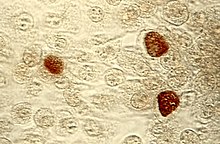
Back متدثرة تراخومية Arabic متدثره تراخوميه ARZ Chlamydia trachomatis Bulgarian Chlamydia trachomatis Catalan Chlamydia trachomatis Czech Chlamydia trachomatis Danish Chlamydia trachomatis German Chlamydia trachomatis Spanish Chlamydia trachomatis Basque کلامیدیا تراکوماتیس Persian
| Chlamydia trachomatis | |
|---|---|

| |
| Chlamydia trachomatis in brown | |
| Scientific classification | |
| Domain: | Bacteria |
| Phylum: | Chlamydiota |
| Class: | Chlamydiia |
| Order: | Chlamydiales |
| Family: | Chlamydiaceae |
| Genus: | Chlamydia |
| Species: | C. trachomatis
|
| Binomial name | |
| Chlamydia trachomatis (Busacca 1935) Rake 1957 emend. Everett et al. 1999[1]
| |
| Synonyms | |
| |
Chlamydia trachomatis (/kləˈmɪdiə trəˈkoʊmətɪs/) is a gram negative, anaerobic bacterium that causes chlamydia and trachoma. C. trachomatis exists in two forms, an extracellular infectious body and an intracellular non-infectious body.[2] There are currently 18 serovars that correlate with medical conditions including: trachoma, lymphogranuloma venereum, nongonococcal urethritis, cervicitis, salpingitis, pelvic inflammatory disease.C. trachomatis is the most common infectious cause of blindness and the most common sexually transmitted bacterium.[3]
The earliest description of C. trachomatis was in 1907 by Stanislaus von Prowazek and Ludwig Halberstädter as a protozoa.[4] It was later thought to be a virus due to its small size and inability to grow in laboratories. It was not until 1966 when it was discovered as a bacterium by electron microscopy where its internal structures were observed.
C. trachomatis attaches to mucosal cells in the body, specifically the lungs, genital tracts, and ocular systems.[3] Many cases are asymptomatic, although symptomatic infections can present themselves in various ways. In the genitourinary system, infection in women can consist of cervicitis, pelvic inflammatory disease, perihepatitis, and endometritis. In men, infections can include epididymitis, prostatitis, and reactive arthritis. Consequences that affect men and women are urethritis, conjunctivitis, pharyngitis, proctitis, and lymphogranuloma venereum.[2]
The impact of C. trachomatis on human health has been driving vaccine research since its discovery.[5]
- ^ J.P. Euzéby. "Chlamydia". List of Prokaryotic names with Standing in Nomenclature. Retrieved 2008-09-11.
- ^ a b Mohensi, Michael; Sung, Sharon; Takov, Veronica (August 8, 2023). "Chlamydia". National Library of Medicine.Mohseni M, Sung S, Takov V. Chlamydia. [Updated 2023 Aug 8]. In: StatPearls [Internet]. Treasure Island (FL): StatPearls Publishing; 2024 Jan-. Available from: https://www.ncbi.nlm.nih.gov/books/NBK537286/
- ^ a b Cite error: The named reference
Elwell2016was invoked but never defined (see the help page). - ^ Cite error: The named reference
Nunes2014was invoked but never defined (see the help page). - ^ Cite error: The named reference
Bergeywas invoked but never defined (see the help page).